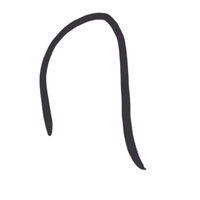Prof. Lynne Allen, Rutgers University, October 2003
When asked what stimulates sculptor Samer Tabbaa, he said ‘it doesn’t take much, like a sip of water in the desert.’ This statement says volumes about the seriousness and longevity of Samer Tabbaa’s art and career, as well as the importance of contemporary sculpture in today’s world. Sculpture was liberated from monumental and commemorative work back in the first decades of the 20th century. Freed from pedestals, sculpture began to explore new materials, materials made to look like other materials, to compete on the wall with paintings, and the utilization of industrial factories in the casting process. Tabbaa’s cast aluminum pieces, mostly untitled, were made in a factory where car parts are cast. These are then corrugated and sandblasted to accentuate one of the most important aspects of Tabbaa’s work, light and reflection. Surface reflection, like a Persian carpet, plays a huge part in the overall mystery of Tabbaa’s work. At first glance, many of the sculptures look extremely simple. This is deceptive. Heftier sculptures appear to be nearly weight-less, and bulky ones are actually an illusion and quite light. This is paralleled in meaning as well, as Tabbaa is a conceptual jester, one who creates and poses mysteries for the audience to decipher, in their own way, from their own experiences. In many of the works we have a sculpture, a physical presence that represents a physical absence – our minds supply the missing space. Does poured lead inside wood represent strength or weakness? Wood can contain steel, but steel is stronger, so who is holding whom? The fact that Tabbaa came to sculpture from a career in social work can be detected in the work; it looks at the world from more than one angle and is asking more questions than answering them. The idea is to ‘blur’ the boundaries and to give you something to think about. A surface plane, with three-dimensional protrusions, also contains recessed empty spaces. The weight of absence, echoes and contrasts against the textural surfaces of many pieces. Cuts and openings that look random nearly become a coded language. Emptiness, is it a trap to anarchy within a system, where you can exist but only within boundaries? Maintaining the integrity of materials has an important place in the idea behind much of Tabbaa’s work. The difference in surfaces treatments, in some cases leaving evidence of the quarrying process, from the raw to the finely polished, brings attention to the intervention of the artist without diminishing the materials themselves. It is about manipulating materials to create shadow, both metaphorically as well as physically, while maintaining the simplicity of materials are what make the work so successful. I like when a piece seems to be in conflict with itself. Identity comes from within. It isn’t something that is collective, and ones artistic language is one’s own. Samer Tabbaa is an artist whose work approaches deeper philosophical questions about existence. His internal necessity to question the complexities of difference, and ability for these differences to coexist, are present in his work through the materials he chooses to work with. All have integrity. All have internal strength yet possess their own special weakness. The art Samer Tabbaa produces has gravity, strength and staying power. A sip of water in the desert.
UK

